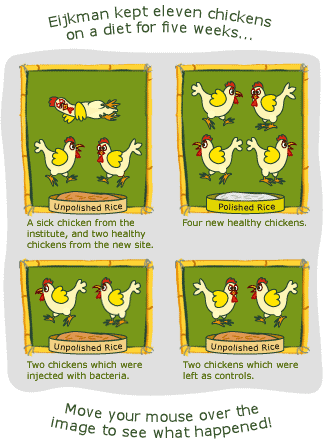Christiaan Eijkman, Beriberi and Vitamin B1
"White rice can be poisonous!" This was the conclusion Christiaan Eijkman declared in 1896 on his return to the Netherlands, after ten years of research in Batavia, Java in the Dutch East Indies (now Jakarta, Indonesia).
Who Was Eijkman and Why Did He Travel to Java?
 |
In Eijkman's time, Indonesia was a Dutch colony and Jakarta was called Batavia. |
Early on Christiaan Eijkman had decided he wanted to become a doctor. When the time came, his family couldn't afford to send him to medical school. Nevertheless, he found the means to get the education he needed. The Dutch colonial army had use for many doctors and they paid for his education in exchange for a few years of medical work in the Dutch East Indies. Christiaan got his medical training, and then went to the colonies to work as an army surgeon. A short time after his arrival he got malaria, and after two years, it became impossible for him to work. He was sent back home to recover.
Back in Europe, he went to Berlin in Germany to study the latest groundbreaking medical research. There, Robert Koch had discovered the tuberculosis bacterium three years earlier, in 1882. At that time it was considered revolutionary. Doctors hadn't had a clue as to why there were diseases like tuberculosis or malaria and they couldn't cure people who suffered from them. Now, after Koch had shown that a bacterium caused tuberculosis, hope was raised that other bacteria that caused diseases could be found. It would be a lot easier to find cures when doctors knew what caused the diseases. To study how tuberculosis was transmitted, Koch developed a method to grow bacteria and infect animals. Eijkman stayed with Koch for a year.
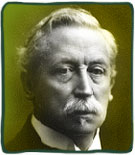 |
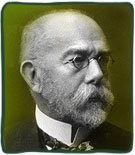 |
| Christiaan Eijkman was born on August 11, 1858 in the Dutch town of Nijkerk. He was the seventh child of the headmaster at the local school. | Robert Koch was Eijkman's teacher in Berlin in 1885. Twenty years later, Koch was to receive the Nobel Prize in Physiology or Medicine for his research on tuberculosis. |
In the 1880s, the disease beriberi reached endemic proportions in the Dutch colonies. In 1886 the army decided to set up a research institute in Batavia, Java. Eijkman was still suffering from malaria and was recently widowed but he decided he wanted to work at the new institute. He was eager to find the bacterium that caused beriberi and, hopefully, a cure.
What Did Eijkman Know About Beriberi?
Eijkman had seen many victims of beriberi while working for the army in the Dutch East Indies. The disease started with signs of weakness, fatigue, irritability, restlessness, loss of appetite and vague abdominal discomfort. As it progressed, patients developed burning sensations, tingling in the extremities, and changes in the sensation such as numbness. Many of the sufferers died of heart failure. Autopsies showed that the nerve fibers and heart muscles had degenerated.
In Asia beriberi had been a known disease for a few thousand years. Suddenly, after the 1870s, it became one of the most common diseases in the region.
Eijkman's Trials; Monkeys, Chickens and Prisoners
During the first years of Eijkman's work at the institute in Java, two of his colleagues managed to extract micro-organisms from people who had died from beriberi. When they returned to Europe they left Eijkman behind as the institute's director.
Eijkman tried to infect rabbits and monkeys with the micro-organisms. However, the animals didn't get sick. Eijkman concluded that beriberi must be a disease which took a long time to develop. To wait a very long time, until the rabbits or monkeys showed signs of beriberi, wouldn't work. Chances that the animals got other diseases in the meantime were too great, and it would only be possible to draw conclusions if he had a very large number of animals to work on. He needed animals which developed the disease more quickly. It would also be good if they were cheap and easy to maintain.
 Eijkman bought chickens and
housed them in large cages in the shadow under the
institute's extended roof. After less than a month,
all chickens got sick. Eijkman thought that the
chickens which he had injected with micro-organisms
had infected the ones without injections. He bought
new chickens and kept them, one by one, in smaller
cages. But these chickens also got sick. Eijkman
realized that the whole institute must be infected
and decided to keep new chickens at another location.
But as he did this, all the chickens got well.
Eijkman couldn't understand what was happening. He
hadn't done anything to cure them!
Eijkman bought chickens and
housed them in large cages in the shadow under the
institute's extended roof. After less than a month,
all chickens got sick. Eijkman thought that the
chickens which he had injected with micro-organisms
had infected the ones without injections. He bought
new chickens and kept them, one by one, in smaller
cages. But these chickens also got sick. Eijkman
realized that the whole institute must be infected
and decided to keep new chickens at another location.
But as he did this, all the chickens got well.
Eijkman couldn't understand what was happening. He
hadn't done anything to cure them!
The man who fed the chickens told Eijkman that he had given them cooked white rice during the period they got sick. It was leftover rice from the next-door hospital. Later, a new cook there didn't want to give him left over rice and he had gone back to feeding them with unpolished uncooked rice. It was after this that the chickens had recovered.
When Eijkman understood that the disease had something to do with the diet, he decided to make trials. He did something like this...
After five weeks, it was clear to Eijkman that the diet did indeed cause the disease. He gave all the chickens unpolished uncooked rice, and the four sick chickens got well again.
Eijkman repeated the experiment just to be sure and concluded that the important difference was that only one kind of rice had been cooked. It must therefore be that cooked rice helped an unknown microorganism to develop into a poison in the intestines of the chickens.
Or, perhaps, it was only cooked rice which had been stored for a few days that became poisonous in this way? He tested this, but no, even the chickens fed with freshly cooked rice became ill.
Or, could it be that the chickens couldn't absorb the nutrients from cooked rice?
Or, could it be that the water they had boiled the white rice in was toxic?
Trials showed that the answer to all these questions was "no." Neither was raw white rice less toxic than boiled. One thing that became clear was that, what mattered was if the rice had been polished or not. Only the chickens fed with polished rice developed the disease. If the chickens were fed polished rice, plus the skin which had been removed, they didn't get sick. For a change, Eijkman fed the chickens with raw meat, and the chickens stayed well. Eijkman's conclusion was that starch had some toxic effect on the chickens. He thought that the skin, which had been removed from the white rice, contained a substance that made the poisonous rice innocuous. Eijkman called this the anti-beriberi factor.
 |
 |
| Brown rice has its outer husk removed. | White rice is polished further to remove the thin skin and the germ. Since the germ is ground off from the white rice grains, they have a slightly pointed appearance. |
Eijkman described the trials in a report. He also wrote about them in Dutch scientific journals, so that other scientists could learn from them.
In 1895, after nine years of research with animals, Eijkman wanted to find out if humans could avoid getting beriberi by eating unpolished rice. He asked a doctor named A. G. Vorderman to carry out investigations in the prisons. The reason why he decided to do this in the prisons was that it was easy to control what people ate, and that the same persons stayed there for a long time. It soon showed that prisoners who were fed polished rice were a lot more likely to get beriberi.
Before the trials in the prisons were completed, Eijkman returned to the Netherlands. Vorderman and other physicians continued their research.
Vitamin B1
In the 1800s, it was known that people needed proteins, carbohydrates, fat and salt to stay healthy. No one had heard of vitamins.
One of the first to find out that food contains other things that people need was Gerrit Grinjs, who now took Eijkman's place at the institute and did more research. He understood that white rice wasn't toxic, but that it lacked something vital.
In 1906, the British biochemist Frederick Hopkins demonstrated that food contains necessary "accessory factors" in addition to proteins, carbohydrates, fats, salts and water.
In 1912, the chemist Casimir Funk thought that he had found the vital substance Eijkman called the anti-beriberi factor. Funk gave it the name Vitamine. (He coined the word by combining "vital" and "amine.") This name later came to denote all vitamins, even if the "e" soon was dropped.
However, Funk hadn't found the right substance. Not until 1926 was the vitamin, which was to be named Thiamin or B1, isolated in its pure form. Its structure was fully elucidated and the vitamin synthesized in 1936.
Even if people hadn't heard of vitamins before the 20th century, many understood that it was important to eat varied food. And most people did. Problems with malnutrition usually occurred when people were on long journeys at sea, working for the army or imprisoned. In Japan a doctor in the navy, Takaki, understood that beriberi could be avoided if the men ate less rice and more vegetables, barley, fish and meat. When he showed how successful this method was, it was made into a naval regulation in Japan. Eijkman had probably not heard about this, even if it happened at the same time as he was on his way to Java.
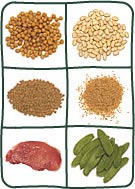 |
Because it is water soluble, B1 is not stored in the body and must be supplied daily. Chickpeas, beans, lentils, brown rice, lean pork and peas are all good sources of vitamin B1. |
Why Was Beriberi Such a Common Disease?
It was in the 1870s that thiamin deficiency became a common disease in many parts of Southeast Asia. In some towns, as many as half of the babies died from it. Europeans had taken steam driven mills to Asia, and the new rice-processing machines completely polished the grains. This rice was considered to be of superior taste and quality, and was eaten by most people in Asia. But, since the polishings had been removed, so had the B1 vitamins. For people who ate mostly rice, beriberi was a sure fate.
Today, beriberi is no longer a common disease. Since the 1940s, food items such as rice, white flour, pasta and cereals are often enriched with Vitamin B1. The practice of eating varied foods and the enrichment of processed foods with vitamins, have helped save the lives of millions.
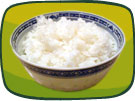 |
People found the polished rice from the new milling machines superior in taste, and they chose it over brown rice even if it was more expensive. |
The 1929 Nobel Prize in Physiology or Medicine
In 1929, Eijkman shared the Nobel Prize in Physiology or Medicine with Frederick Hopkins.
 |
Christiaan Eijkman was awarded the Nobel Prize in Physiology or Medicine in 1929. Due to bad health, he couldn't come to Sweden to receive the Prize. He died a year later. |
One may wonder why Eijkman was awarded the Prize for the discovery of vitamin B1 even if he himself didn't discover it.
Eijkman was actually awarded the Prize because he was the first to point out a substance in the rice skin - a substance not to be known as the anti-beriberi factor as Eijkman called it, but what later was to be known as vitamin B1. He was also awarded the Prize for his new way of investigating and his methods to control diseases caused by vitamin deficiency. His trials had become famous, and in the late 1920s it was obvious that his work had spurred developments in nutrition research.
First published 25 November 2003
Further Reading
About Eijkman at this
Site:
Presentation
Speech from the Prize Award Ceremony in 1929
»
Christiaan
Eijkman's Biography »
Christiaan
Eijkman's Nobel Lecture »
The Chicken Farm Game »
Recommended
Book:
Kenneth J.
Carpenter, Beriberi, White Rice and Vitamin B (University of California Press, 2000).
MLA style: "Christiaan Eijkman, Beriberi and Vitamin B1". Nobelprize.org. Nobel Prize Outreach AB 2022. <http://nobel-external-educationalgames-app.azurewebsites.net/educational/medicine/vitamin_b1/eijkman.php>
